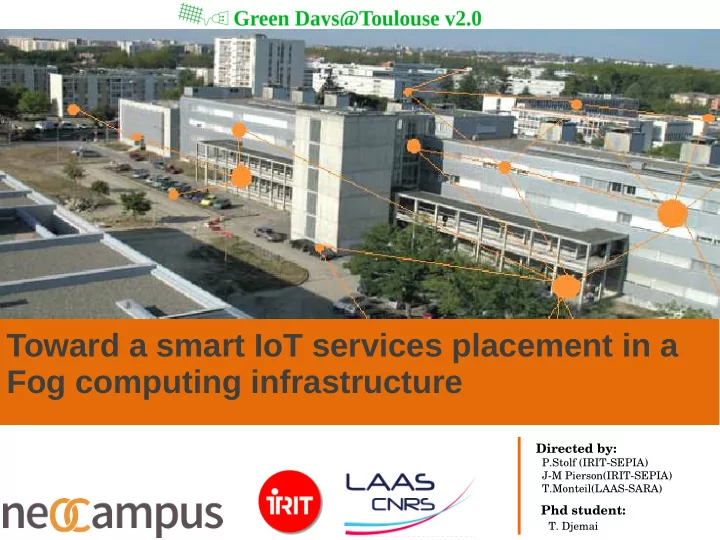

Toward a smart IoT services placement in a Fog computing infrastructure Directed by: P.Stolf (IRIT-SEPIA) J-M Pierson(IRIT-SEPIA) T.Monteil(LAAS-SARA) Phd student: T. Djemai
Plan ✔ Context and Challenges ✔ Objectives ✔ Actual Work ✔ State of progress ✔ Future Prospect
1 Context and challenges ➢ IoT objects proliferation ➢ Real time, Network greedy applications. ➢ Users Quality of Service requirements. ➢ Centralized distant computing infrastructure. IoT environnement (cloud paradigm) + ➢ Dedicated network equipments Extension Cloud paradigm Fog computing paradigm Context & Challenges Objectives Actual Work State of progress Future prospect
2 Context and challenges (2) Fog computing infrastructure NIST view (NIST 2017 [5]) Simplified view of Fog infrastrucutre ➢ Multi-layer Heterogeneity (Users, Network and Cloud). ➢ Highly distributed geographical area. ➢ High number of users, equipments (Scalability) and high mobility. ➢ Quality of Service Requirements (Augmented Reality, Connected Vehicles, Health Care). ➢ Consequent energy consumption (Cloud + Network + IoT Objects). ➢ Management of Fog-cloud and Fog-User communication. Context & Challenges Objectives Actual Work State of progress Future prospect
3 Objectives ➢ Model and implementation of an Autonomous Framework for IoT services placement and orchestration Optimization Prediction Models Apps Submission policies system G-Network control system Orchestrator G-Energy control/mangement system (Scheduler) G-compute control system Zone N Zone 1 (Fog Cloudlet N) (Fog Cloudlet 1) Z-Orchestrator Z-Network control system Z-compute control system Z-Energy control/mangement system IoT devices Layer Apps requests A high level view of IoT services orchestrator Context & Challenges Objectives Actual Work State of progress Future prospect
4 Actual objectives Energy consumption minimization ➢ Energy consumed for compute. ➢ Energy consumed for the network communication . Timeliness and Service Deliver ➢ Each service has a maximum execution time that should not be exceeded. ➢ Each pair of services that exchange data has a maximum communication time not ot be exceeded. Context & Challenges Objectives Actual Work State of progress Future prospect
5 Approach and methodology(1) I.Model Fog Infrastructure IoT application A Directed Acyclic graph (DAG) ➢ Nodes = Services A three layered hierarchical infrastructure (Cloud, Fog/edge, ➢ Vertices= Represent data dependecies between IoT devices) modeled by A Directed Acyclic graph ➢ Nodes = Physical equipements. services. ➢ Vertices = Physical links. S4 S4 S1 S1 S2 Sensor S2 Sensor Actuator Actuator s3 s3 Context & Challenges Objectives Actual Work State of progress Future prospect
6 Approach and methodology(2) II.iFogSim Fog environment simulator based on CloudSim. IoT services placement process A view of the fog infrastructure through iFogSim GUI dp(Si,Sj) : Dependency degree between two services Si and Sj. ➢ Data size exchanged between Si and Sj ➢ Send frequency Context & Challenges Objectives Actual Work State of progress Future prospect
7 Approach and methodology(3) III.Algorithm First greedy heuristic’s Pseudo algorithm (using dependency degree) IN : - List of Infrastructure’s nodes in ascending order of capacity. -List of applicaiton Edges in descending order of their dependency degree. OUT : Placement strategy list {« node, {Services} » } 1. For each application’s Edges list EL do 2. while all services in EL are not placed do 3.chek if si and sj are not placed 4.For each node nk in nodes list NL do 5.For each node nl in nodes list NL do 6.Check if nk & nl ressources are respectively enough for si, sj & delays constraints are respected. 7.if E is minimal then placed si in nk and sj in nl 8. if si is placed then try to place sj with E minimal ( redo 5 & 6 for nl) 9. if sj is placed then try to place si with E minimal ( redo 5 & 6 for nl) (S2,S3) (S1,S4) (S1,S2) (S4,S5) EL F2 F1 F3 F4 C1 C2 NL Context & Challenges Objectives Actual Work State of progress Future prospect
8 Approach and methodology(4) IV.Real test infrastructure Architecture of our realistic testbed Context & Challenges Objectives Actual Work State of progress Future prospect
9 State of progress ➢ Placement strategies in ifogSim. ➢ Random with threahsold ➢ Compare with Fog Only, Cloud Only and EdgeWare strategies. ➢ CiscoIR829 Smart router manipulation. Context & Challenges Objectives Actual Work State of progress Future prospect
10 Future Prospects Integrate user mobility. ➢ Integrate IoT application classes according to their QoS ➢ requirements. Establish probabilistic models for resource estimation. ➢ Dynamic adaptation to context change (eg : Network congestion ➢ point, network and ressources states) . Context & Challenges Objectives Actual Work State of progress Future prospect
T H A N K Y O U F O R Y O U R A T T E N T I O N
References [1] Z. A. Bonomi, Milito. Fog computing and its role in the internet of things.MCC’12, August 17, 2012, Helsinki, Finland, -1, 2012. [2] C. company. Cisco fog computing with iox.IEA 4E EDNA, T echnology and Energy Assessment Report, -1, 2014. [3] L. L. Giang, Blackstock. Developing iot applications in the fog: a distributed datafmow approach.5th International Conference on the Internet of Things (IoT), -1, 2015. [4] G. B. Gupta, Dastjerdi. ifogsim: A toolkit for modeling and simulation of resource management techniques in the internet of things, edge and fog computing environments.IEEE, -1, 2016. to appear. [5] B. M. G. M. Iorga, Feldman. Fog computing conceptual model recommendations of the national institute of standards and technology.NIST Special Publication 500-325, -1, 2017.
Recommend
More recommend